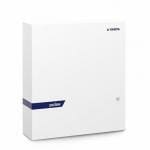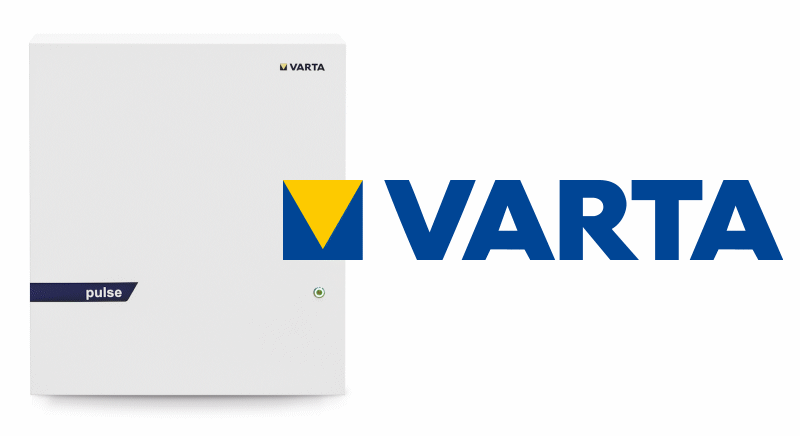Background on VARTA – Company History
VARTA is a German company that has a long history in the battery market. It was founded in 1887 by Adolph Muller in Hagen, Germany.
In 1977, VARTA AG’s businesses were split up. VARTA AG retained the battery and plastics operations. Another company called Altana took over the pharmaceuticals and specialty chemical businesses.
Today, VARTA AG exclusively produces and markets a wide range of battery products from micro batteries, to household batteries and energy storage systems. They employ almost 4,800 people with five manufacturing facilities in Europe and Asia.
For the 2020 financial year, they earned revenues of over 869 million Euros with a market cap of 4.9 billion Euros.
They entered the energy storage industry in 2012 with the establishment of the business unit VARTA Storage. They sell two flagship products in their “Pulse” range. The Pulse 3 is a 3.3kWh system with the higher capacity Pulse 6 being a 6.5kWh system.
The VARTA pulse was awarded the most efficient amongst AC storage systems by the Berliner Hochschule fur Technik und Wirtschaft (HTW Berlin). With a result of 98 percent average battery efficiency, it was the highest battery efficiency recorded in energy storage system inspections.
In 2016, they expanded their energy storage division into Italy. Then in 2018, they entered the Australian market. Unlike some other battery manufacturers who tend to use authorised distributors to sell their products in the market, VARTA Storage is exclusively banking on distributing through the installers only.
VARTA’s market information claims that around 70% of installations are as a result of installers recommending their system to the homeowner directly. This, they claim, has helped them to account for 12% of the market share in Switzerland, Germany and Austria combined.
As of March 2024, Varata have shifted its focus towards automotive, vehicles, and heavy commercial batteries, with limited or no information available about their new products related to solar residential battery solutions.
Basics of the VARTA Pulse 3 and Pulse 6 Lithium Battery
Pulse 3
The Pulse 3 is a nominal capacity 3.3kWh lithium battery with a usable capacity of 3.0kWh. It’s an AC all-in-one system with an integrated battery inverter. This makes it useful for both new installations as well as retrofitting to an existing PV solar system.
The storage capacity can be expanded to a maximum of 5 VARTA modules using VARTA link. This would give it a total nominal capacity of 16.5kWh with a usable capacity of 15kWh which would place it in the range for most residential household requirements but would put it on the lower end of the spectrum for commercial solar needs. With using the VARTA link, you must ensure the battery modules have the same capacity, i.e. you can’t combine the 3.3kWh Pulse with the 6.5kWh version.
Both the Pulse 3 and Pulse 6 have been designed to only be installed indoors with a rating of IP 33 protection. This is reflected in an operating temperature range of 5 to 30 degrees Celsius.
You can monitor your consumption and production data with the VARTA Online Portal (website) or the VARTA App. It states in their documentation that you can connect the Pulse with different inverters but doesn’t say what specific models or brands it’s compatible with.
The battery chemistry consists of Lithium Nickel Manganese Cobalt Oxide (NMC) which is known for having a higher energy density and longer life cycle than Lithium iron Phosphate (LFP) which is more commonly used.
Pulse 6
The Pulse 6 is essentially the same as the Pulse 3 except that it’s bigger on a few fronts. With a 6.5kWh nominal capacity along with a usable capacity of 5.9kWh gives it almost twice the power of the Pulse 3. Like the Pulse 3, up to 5 modules can be hooked up giving a total usable capacity of 29.5kWh.
It’s also noticeably heavier at 65kg compared with the Pulse 3 which is 45kg.
Key Features
There are a number of features of the VARTA battery worth mentioning:
Fully Integrated System
VARTA Storage touts the pulse as an “All-in-one” system with an integrated battery inverter built in. They have claimed that it would take less than half an hour or closer to 15 minutes to set up due to it’s plug-and-play out of the box design that doesn’t require any external components as mentioned by Gordon Clement, VARTA’s GM Power and Energy in PV magazine.
High Efficiency
As mentioned, the VARTA pulse was awarded the most efficient storage system at HTW Berlin at 98% efficiency. Battery efficiency is an important factor to consider, as it represents the ratio of the battery retrieved from the battery to the energy provided to the battery. Therefore the more you can get out of the battery, the better utility you can get out of it.
Compact Design
The Pulse is fairly compact for a combined battery inverter and energy storage system. Measuring 600 x 690 x 186 mm (W x H x D) and weighing at 45kg and 65kg for the Pulse 3 and Pulse 6 respectively, it is designed to be hung on the wall to save floor space. This would particularly suit homeowners whom floor space is a valuable consideration.
How Much Do VARTA Batteries Cost?
We’ve reached out to VARTA for wholesale prices for the Pulse 3 and Pulse 6 and are yet to hear back from them.
Compare quotes from up to 7 installers in your area now.
Australian Warranty Terms for VARTA Pulse Batteries
The Warranty terms for the Pulse can be divided into offline and online categories, due to the nature of the system’s ability to connect online to monitor and optimise it’s usage.
Operated Offline: – Battery Modules
According to VARTA’s warranty documentation, a warranty can be claimed if the battery modules are defective within 10 years from the date of installation or before 4000 cycles have been achieved, whichever occurs first.
It’s important to note how the term “defective” is defined. For the purposes of the warranty, “defective” is when the total capacity of the battery system fails to reach 80% of its usable total capacity.
VARTA Storage will then at their discretion either repair or refund the fair value of the battery modules.
Operated Offline: – VARTA System (Excluding Battery Modules)
According to VARTA’s documentation, a warranty can be claimed if the VARTA System (excluding Battery Modules) is defective within a 5 year period of installation.
Again, note “defective” is defined as if the system “no longer has the performance characteristics which the End Customer may expect according to the VARTA Storage product description”. The way this term has been defined is somewhat vague and subject to interpretation, so could potentially lead to potential claims from an end user that may not be validated by VARTA Storage.
Operated Online: – VARTA System & Battery Modules
The warranty terms and conditions are the same for Battery Modules as per the off-line warranty documentation. However, the VARTA System (excluding Battery Modules) is warranted for up to 10 years from the date of installation.
To make a claim directly with VARTA Storage, it must be done within 2 months that the End Customer has identified the defect. Email info@varta-storage.com or Phone +49 9081 240 86 60
We’ve reached out to VARTA to see if a warranty claim can be claimed by an installer in Australia and are yet to hear back from them.
Battery Specifications Comparison for Pulse 3 & Pulse 6
| Pulse 3 | Pulse 6 | |
| Usable Capacity | 3.0 kWh | 5.9 kWh |
| Max. AC Power charge/discharge | 1.6/1.4 kW | 2.5/2.3 kW |
| Cycle Life | > 4000 Cycles | > 4000 Cycles |
| System Connection | Up to 5 using VARTA link | Up to 5 using VARTA link |
| Battery Cell Technology | Lithium NMC | Lithium NMC |
| Dimensions | 600 x 690 x 186 | 186 |
| Weight | 45kg | 65kg |
| Operating Temperature Range | 5 to 30 degrees Celsius | 5 to 30 degrees Celsius |
| Outdoor/Indoor | Indoor only (IP33) | Indoor only (IP33) |
| Warranty on batteries | 10 years or 4,000 cycles* | 10 years or 4,000 cycles* |
| System Warranty | 10 years (with internet); 5 years (without internet) | 10 years (with internet); 5 years (without internet) |
*Residual capacity of 80%.
Read more product reviews from Solar Choice
Since 2008 our knowledge and sophisticated software has allowed over 300,000 Australian households and businesses to make a well-informed choice on their solar & battery installer.
